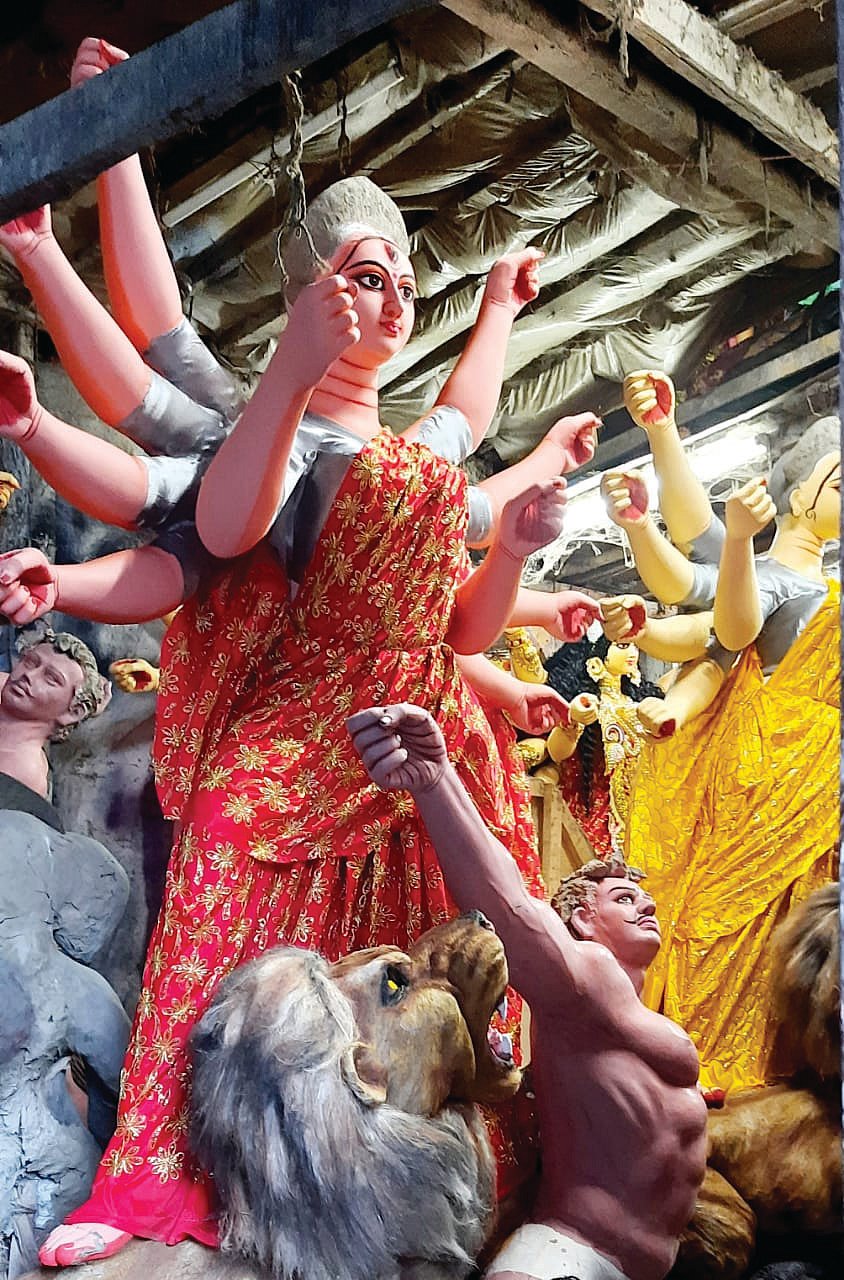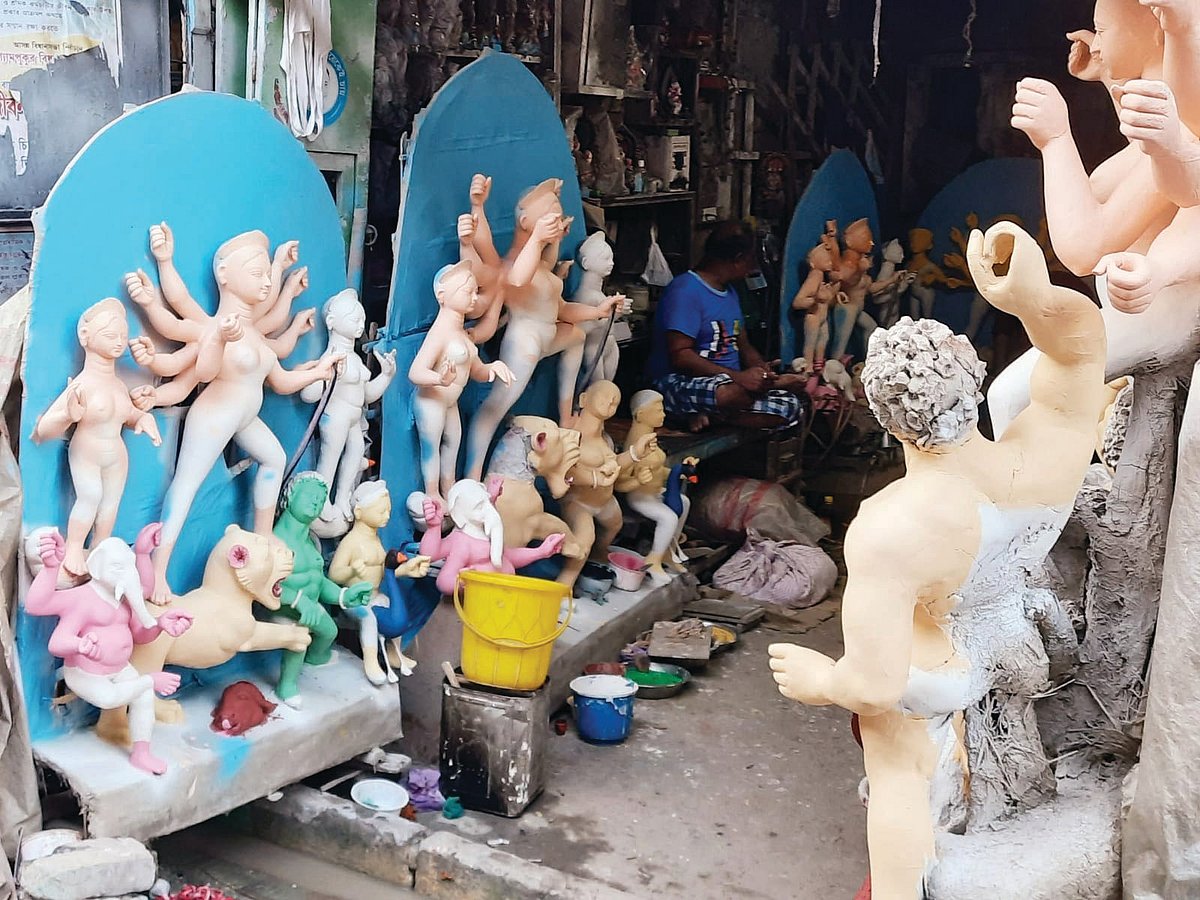Welcoming Ma Durga-What goes into making 'Protima' for the Puja
Hailed as a public art exhibition on par with Venice Biennale & Rio Carnival, Durga Puja this year begins on October 11. The writer visits Kumartuli in North Kolkata to describe how the idols are made

Venice, Munich or Rio, however, do not have the devotional aspect of Durga Puja, which celebrates the home coming of the ten-armed warrior goddess and worships her. In Bengal it is also known as the autumn festival or Sharod Utsav.
The centre of attraction has always been the majestic, beautiful and varied idols, called Protima or Murti, the innovative and startling designs of idols, decoration, lighting and the pandals or marquees designed to depict recent events or historic monuments.
While traditionally potters would start making the idols in June-July on the day of the Rath Yatra, many of them now begin even earlier to cope with demand. The process starts with a customary obeisance paid to Ganapati or lord Ganesha, who is believed to ensure commercial success.
Idols are built with bamboo, straw, jute husk, wood and alluvial soil. The attires are made of cotton or silk, embroidered with zari and brocade while the jewelleries are created from papier mâché, thermocol and foils. Colours are created by mixing Khori Mati, a special clay prepared from sea froth, with colouring chemicals and a glue prepared from tamarind seeds, which help the colour to last.

An organic varnish known as Gham Tel- literally meaning the sweat oil - is applied to create the glaze. Thin iron foils or aluminium are often used over the weapons. All materials including paint are biodegradable and organic to avoid polluting the water after immersion.
This is in contrast to the Ganapati idols worshiped in Mumbai, where they are made mostly of Plaster of Paris. The armaments that adorn Durga idols are never immersed and hence the metal foils do not pollute the water.
Individual bamboo frames are made first for all the seven figurines - Durga, her lion and Mahisasura, Saraswathi with her swan, Lakshmi and her owl, Ganesha with his mouse, and Kartik with a peacock.
Potters then use straw and sticks to give shape to the limbs and the torso. The sticky, smooth, alluvial clay mixed with jute husk and fibre are then put on the skeletons. They are then left to dry in the sun, following which they are hand polished to give them the required anatomical shape, and hand painted.
***

The heads are sculpted separately because the head needs intricate measurements of the physiognomy of the idols to ensure the right proportion. They also require expert handling to create the right expression. Heads are then attached to the idols before the painting begins.
The eyes are painted last, usually on the morning of Mahalaya, which marks the end of Pitri Paksha or Shraddh, the 16-day mourning period for ancestors. Devotees believe that Ma Durga with her children starts her journey to her father’s home on earth on this day from Mount Kailash. Only the senior most potter is given the privilege of drawing the eyes of the Devi, which finally make the idol come alive.
Four elements—deemed to be pure—are considered essential in the making of the idols. They are the mud from the banks of the Hooghly River- a tributary of the Ganga - called Ganga Mati, urine of a cow - Gomutra, cow dung or Gobar and soil from a prostitute’s doorstep referred to as the sacred earth.
Historically, Kumartuli potters have been fetching the sacred soil from adjacent Sonagachi, the largest red-light neighbourhood in Asia. Earlier, a senior potter or priest would formally beg a sex-worker for her consent to carry the soil from her doorstep.
The tradition stems from the belief that when a man enters a brothel, he leaves all his virtues behind. Hence, the soil of a courtesan’s doorstep is the purest as she absorbs all the evil of the society, in order to keep society pure and safe.
Follow us on: Facebook, Twitter, Google News, Instagram
Join our official telegram channel (@nationalherald) and stay updated with the latest headlines
